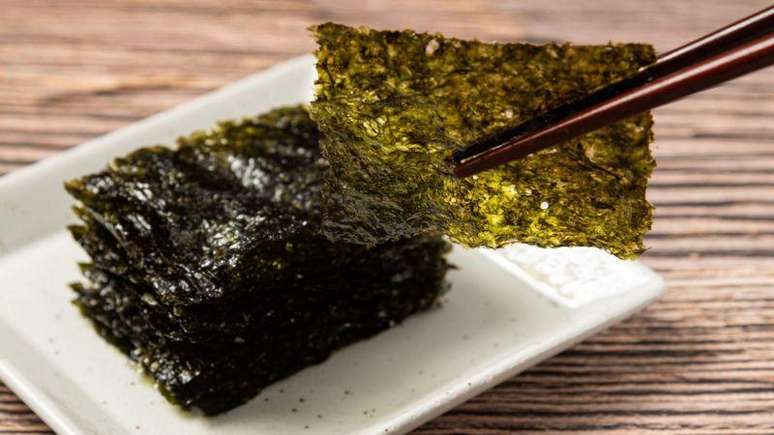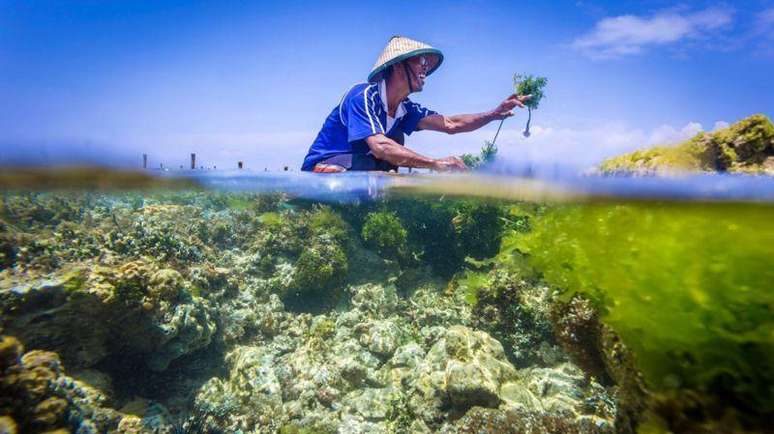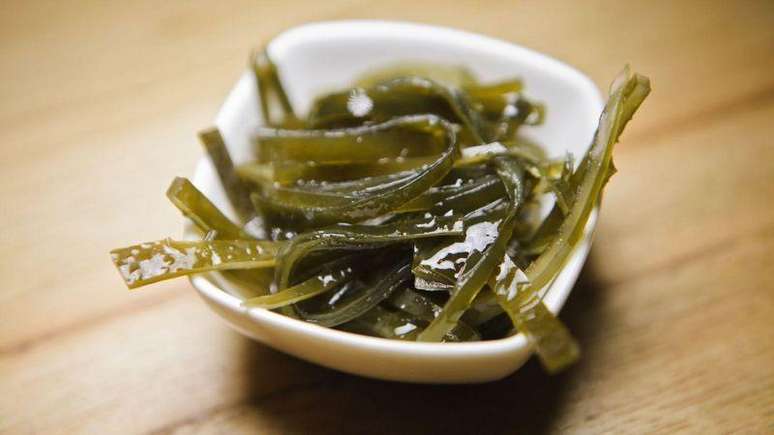Gradually, seaweed is becoming more and more known in the West, where it is considered a nutritional and sustainable “superfood”. But how true is this?
Have you ever wondered why your homemade ice cream is covered in ice crystals while industrial ice cream isn’t? Or why are the onion rings all the same size, even though the onions are smaller at the ends?
Or why does the beer you forgot in the glass continue to foam even half an hour later?
This is all due to seaweed extract, also known as alginate, a natural fiber, says Jeffrey Pearson, professor of molecular physiology at Newcastle University in the United Kingdom.
Although hidden in some foods in the West, seaweed is widely consumed in coastal areas of Asia.
And little by little they are becoming more and more known in the West, where they are considered a nutritional and sustainable “superfood”. But how true is this?
Some parents in the United States have chosen to replace greasy, salty chips with supposedly healthier dried seaweed.
Nonetheless, highly processed seaweed snacks can be high in salt and other additives and should be consumed in moderation.
Overweight or obesity
According to Pearson’s recent findings, some species of algae could also help control weight in overweight or obese people.
This, he explains, is because alginate inhibits lipase, an enzyme that helps the body digest fat, meaning it can reduce the amount of dietary fat digested by around 75%.
Pearson and his researchers used an artificial intestine to test the effectiveness of more than 60 natural fibers, measuring the amount of fat digested and absorbed when consumed with common foods such as bread and yogurt.

Pearson now plans to carry out clinical trials to examine this effect when alginate is consumed as part of a normal diet and hopes that his research will lead him to introduce more alginate into foods such as bread to help people control their weight.
Seaweed doesn’t just help you lose weight. Large studies conducted in Japan found a correlation between daily consumption of seaweed and lower rates of heart disease compared to those who did not eat seaweed, and a lower risk of stroke in men.
However, a recent review of 25 studies examined the health benefits of consuming seaweed.
It turns out that many studies showing positive health outcomes related to a seaweed-rich diet were conducted on people with health problems such as obesity and type 2 diabetes, rather than the general population.
“In healthy individuals, seaweed most likely provides no health benefit,” says the paper’s lead author, João Pedro Trigo.
However, eating between 5 and 10 grams of seaweed per day can provide nutritional benefits thanks to the fiber and nutritional content of seaweed, adds Trigo.
However, very little is known about how processing and fermentation affect how the body absorbs nutrients from algae.
Potential risks
There are also some concerns about the potential risks of arsenic, lead and iodine found in seaweed.
Some species of algae may contain more arsenic than others, says Florent Govaerts of the Norwegian food research institute Nofima.

“You can have the same species and one will contain much more arsenic than the other, depending on where it is produced,” he says.
Arsenic levels in algae often vary depending on the arsenic content of the water in which they grow.
But while there are real concerns about the extent to which our diet can expose us to heavy metals, Alec Watt, director of macroalgae exploration at Green Ocean Farming in the UK, says all seaweed sold for human consumption is tested first.
“There are processes to control algae,” he explains.
The type of algae that contains arsenic is organic, which the body eliminates through urine, Pearson says.
Seaweed can also contain high levels of iodine, but again the amount depends on the species of seaweed.

“You can get a lot of iodine if you eat a lot of seaweed,” explains Ingrid Undeland, a professor of food science and nutrition at Chalmers University of Technology in Gothenburg, Sweden.
“These are relatively small amounts before reaching the approximate recommended daily intake. It also depends on the species and whether there are metals or unwanted elements in the water, which is a difficult message to convey,” he says.
Too much iodine can cause thyroid problems in some people, and more immediate side effects include nausea and vomiting.
Additionally, studies have shown that various types of processing – including washing, blanching, boiling, soaking, drying and fermenting – can reduce the amount of iodine in some seaweed species.
Particular flavour
However, the question of taste remains. Although seaweed extract doesn’t taste like anything, Pearson says, he tested it on whole seaweed and found mixed results.
“We found that people don’t like it and don’t ask for more,” he says.
Studies show that some people may be more skeptical of foods they are unfamiliar with.
However, researchers have recently discovered evidence that, contrary to popular belief, seaweed was an important part of the diet of ancient Europeans during the transition to agriculture.

The researchers examined the dental tartar of 74 people across Europe and found evidence that people ate seaweed during the Mesolithic period, about 8,000 years ago, and the Neolithic period, 6,000 years ago.
“No one had found direct evidence of seaweed eating before the prehistoric archaeological record. It was really unexpected,” says Karen Hardy, co-author and professor of prehistoric archeology at the University of Glasgow.
“We have preconceived ideas about what food is like in Europe, and seaweed isn’t the first thing that comes to mind,” he says.
Perhaps, therefore, getting used to the taste of seaweed is not so difficult after all.
The reputation of algae
However, there may be some confusion about how to eat seaweed and incorporate it most effectively into our diet.
Watt recommends chopping dried seaweed and sprinkling it on food as a way to season it. But while he’s passionate about the benefits of seaweed, he’s not optimistic about seeing frozen seaweed in supermarkets any time soon.
“We need a celebrity chef to promote them,” he says.

Despite the apparent lack of information about seaweed, the reputation prevails that it provides numerous health benefits.
When Govaerts conducted a survey to measure knowledge and understanding of seaweed, he found that people in Norway and the United Kingdom, for example, generally have very little knowledge about the topic, beyond believing that it is quite healthy and sustainable.
But to further complicate algae’s message, researchers argue that it’s not as simple as saying algae is healthy or unhealthy, safe or dangerous, because there are so many species.
Referring to all species of seaweed simply as “seaweed” is like referring to all legumes simply as “legumes,” Govaerts says.
Seaweed species don’t just vary in taste: their nutritional profiles are also very different. And the nutritional value of seaweed varies not only from species to species, but also depending on the water in which it grows, explains Undeland.
“We should stop talking about ‘algae,’ because they are very different in how they relate to each other and what they contain. Some may be healthier than others and contain more protein,” says Undeland. “There are 145 edible species and six produced in large quantities.”
It remains to be seen whether seaweed – or certain species of seaweed – will become more entrenched in the Western diet in the near future.
There are still many unknowns about iodine and arsenic contamination, but the European Food Safety Authority is monitoring the growing popularity of seaweed to better control this problem.
But celebrity chefs or not, seaweed is associated with many health benefits and could become a more popular and healthy addition to the Western diet.
This article was published on BBC Future. Click here to read the original version.
Source: Terra
Ben Stock is a lifestyle journalist and author at Gossipify. He writes about topics such as health, wellness, travel, food and home decor. He provides practical advice and inspiration to improve well-being, keeps readers up to date with latest lifestyle news and trends, known for his engaging writing style, in-depth analysis and unique perspectives.









